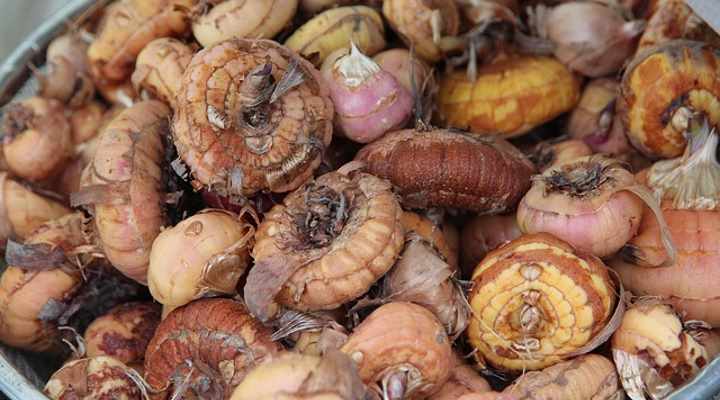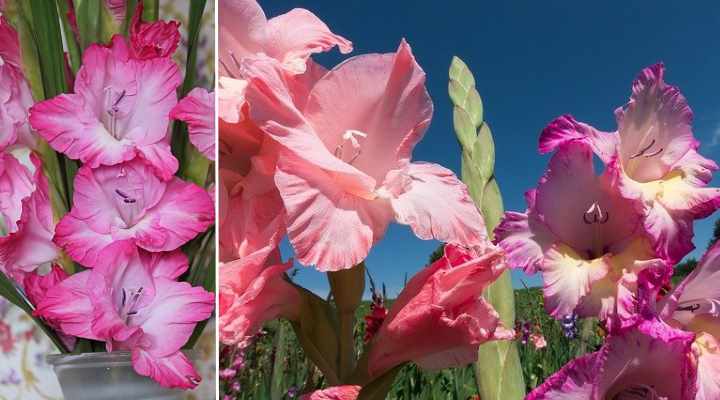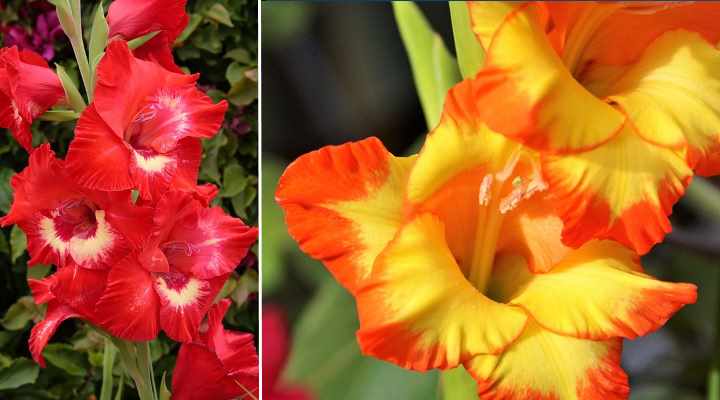Gladiolus: Planting, Caring and Growing Gladiolus Flowers (Pictures)

Gladiolus flowers are beautiful flowering spikes that produce showy trumpet-shaped blooms in spectacular bright summer colors. Gladiolus plants start flowering 10 to 12 weeks after planting. After that, the colorful flowers bloom for a week or so. To ensure tall gladiolus flowers bloom from summer until frost, you can plant the bulbs in your garden flower bed every few weeks.
Gladiolus flowers are easy to grow and require little maintenance. The flowering stalks grow from corms (bulbs) and produce abundant flowers on each flower spike. Gladiolus flowers can come back every year in warmer climates. But most people dig up gladiolus bulbs to store in a cool, dark place through the winter, ready for planting the following spring.
This article is a comprehensive guide to planting, caring, and growing gladiolus flowers. Handy tips on growing gladiolus bulbs will help ensure that these majestic flowers fill your summer flower garden with plenty of color and fragrance.
About Gladiolus Flowers

Gladioli are tall flowering perennial plants with showy flowers and narrow leaves
Gladiolus flowers grow from corms and are usually referred to as summer bulbs. The round, fibrous corms produce branchless stems that can produce up to 30 funnel-shaped showy flowers. Each gladiolus plant has long 1 – 9 narrow sword-like leaves.
There are around 300 species of gladioli, most of which are native to South Africa or other tropical regions in East Africa. Most gladiolus species are hybridized plants and produce impressive flowers with smooth, rippled, or ruffled showy tubular blooms. The main gladiolus flower cultivars and hybrids are from the species ‘Primulines,’ Grandiflorus,’ and ‘Nanus.’
Because of their tall flowering spikes with showy blooms and sword-like leaves, gladiolus also has the name sword lily. The tall colorful flower spikes can grow between 2 and 5 ft. (0.6 – 1.5 m) tall. The taller gladiolus flowers require staking to prevent wind damage. Also, some people refer to the flowers simply as “glads.”
Gladiola flowers are winter hardy in USDA zones 8 through 11. In cooler climates (zones 6 and 7), the bulbs can stay in the ground during winter if you provide a few inches of mulch. However, gladioli may flower better if you dig up the corms in the fall and prepare the bulbs for winter storage indoors in colder regions.
Gladiolus flowers are ideal for growing at the back of flower beds to provide visual height. Smaller gladiolus varieties are also perfect for planting along borders, in containers, or as cut flowers. With little care and maintenance, you can enjoy their cheerful colors and eye-catching vertical lines as they bloom throughout the summer.
Gladiolus flowers come in almost every color imaginable apart from true blue. You can enjoy showy yellow, lilac, pink, red, white, or multi-colored flowers in your garden or a vase at home.
How Long Does It Take for Gladiolus to Flower?

Gladiolus flowers are also called sword lilies and come in a wide array of colors and color combinations
After planting gladiolus corms, the gladiolus bulbs take between two and three months to bloom. Therefore, the best time to plant the gladiolus bulbs in loose soil is in early spring. This will mean that gladiolus flowers will start blooming from July. Gladiolus flowers don’t last long. Therefore, if you plant bulbs every two or three weeks, gladiolus flowers will persist in garden beds until the first frost.
How Long Do Gladiolus Flowers Last?
Gladiolus flowers typically have a short bloom time. Gladiolus flowers usually last up to two weeks on the stalk. After the gladiola bulbs start blooming in early summer, the flowers appear first at the base of the stem. To extend the blooming time, deadhead the gladiolus flowers after they have faded.
Why Are Gladiolus Not Flowering?
A few reasons why gladioli corms fail to produce flowers are due to a lack of sunlight, over-fertilizing, or excessive soil moisture. Although gladiolus flowers are easy to grow in most summer gardens, they require full sun for best results. In addition, gladiolus bulbs left in damp soil may rot over time and fail to come back the following year.
Where to Plant Gladiolus Bulbs

Gladiolus bulbs
Plant gladiolus bulbs in a sunny location. Gladiolus flowers thrive in full sun and moderately fertile, well-drained soil. Ideally, gladioli perform best in sandy soil, as heavy clay soil restricts flowering because it holds too much moisture. Throughout the summer, it’s essential to keep the soil moist by watering regularly.
Top gladiola care tip: Always avoid soggy soil to ensure healthy, beautiful blooms.
When to Plant Gladiolus Bulbs
Planting time of gladiolus determines bloom time, so plant the gladiolus corms ten to 12 weeks before you expect to see flowers on the tall, erect stalks. Plant the gladiolus bulbs in spring when the danger of frost has passed. If you want spikes of flowers throughout the summer, plant the gladiolus corms every two weeks during spring and summer.
In many areas in the northern hemisphere, March is the best month to plant sword lily corms.
How to Plant Gladiolus Bulbs
Plant gladiolus flower bulbs about 4 inches deep (10 cm) in the soil with the flat side down. To prepare the ground, dig a trench 12 inches (30 cm) and work in compost about 4 inches (10 cm) deep. The fertile soil should be loose and well-draining.
Plant the gladiolus corms about 6 to 8 inches (16 – 20 cm) apart. If you are growing gladioli for cut flowers, it’s best to plant the bulbs in rows. If you are planting for visual effect, plant the gladiolus flower corms in groups of seven or more. Then thoroughly water the ground.
Top tip when planting gladiolus bulbs: The larger corms produce the largest flowers.
Planting Gladiolus Bulbs in Pots or Containers
Gladiolus flowers are excellent for growing in containers. Like growing in the ground, “glads” perform best in loose, well-drained soil that is moderately fertile. The container should have drainage holes to prevent the corms from sitting in soggy soil. Typically, smaller gladiolus varieties perform best in pots.
To plant gladiolus corms in a container, you’ll need a pot that is 12 inches (30 cm) wide and deep. The sword lily bulbs should be planted 3 to 6 inches deep (7.5 – 15 cm) with the pointed end facing up. Space the corms between 2 and 3 inches (5 – 7.5 cm) apart.
As a rule, gladiolus corms need 2 to 4 inches (5 – 10 cm) of soil beneath them when growing in pots.
After planting the gladiolus bulbs in containers, thoroughly water the soil. Then water every two to three weeks to keep the soil moist but not soggy. When the container plant flowers bloom, leave them on the plant or cut them to make a floral display. Deadheading gladioli growing in containers helps to promote continuous blooming.
At the end of the season, remove the gladiolus bulbs from the pot, put them in a cool, dry place to dry out. Then store the bulbs ready for planting the following year.
How to Care for Gladiolus Flowers Throughout the Season

To care properly for your gladioli, keep the soil moist but not soggy
Gladiolus flowers can fill your summer garden with a constant supply of magnificent colorful blooms. However, to ensure that you can enjoy the “glads” from summer until fall, you must follow a few care tips. Proper watering, fertilizing and trimming help to ensure healthy flowers.
Watering Gladiolus Flowers
Water gladiolus flowers enough to keep the soil constantly moist but not soggy. It may be necessary to give at least 1 inch (2.5 cm) of water weekly during the summer, especially if there is no rain. Adding mulch around the flowering spikes can help to keep the soil moist and warm.
It’s good to remember that gladioli aren’t drought-tolerant, so you may need to water more often during dry spells or if they are growing in raised beds.
Fertilizing Gladiolus Flowers
Gladiolus flowers benefit from moderate fertilization while they are growing. When preparing the soil for planting, work in a reasonable amount of organic fertilizer to improve nutrient content. Then, when the flowering stalks are about 10 inches (25 cm) tall, apply an organic, water-soluble fertilizer. After that, use the fertilizer again when flowers appear.
Trimming and Pruning Gladiolus Flowers
Cutting gladiolus flowers depends on whether you grow them for cut flowers or to enhance your garden’s beauty. If growing “glads” for floral arrangements, cut the stalk when there are three blossoms on the lower part. However, remember to leave a minimum of four leaves to prevent the corm from dying.
When growing gladioli for their colorful tall flower stalks in a garden, you should deadhead the blooms when they start to fade. Deadheading gladioli extends their bloom time and prevents the flowers from seeding.
How to Mulch Gladiolus Flowers
Putting a layer of organic mulch helps to retain moisture and keep an even soil temperature. Put a 2 to 3-inch (5 – 7.5 cm) layer of leaf mulch, bark mulch, or straw over around the emerging gladiolus stalks. Mulching gladiolus flower stalk also helps with weed control—a factor that can affect gladiolus blooming.
If you plan to leave gladiolus bulbs in the ground over winter (in zones 6 or 7), then apply a thick layer of organic mulch in autumn. This should help protect the corms in the ground during mild winter months.
How to Stake Gladiolus Flowers
Taller varieties of gladiolus flowers over 3 feet (1 m) tall benefit from staking to prevent the tall flowering stalks from falling over. The time to stake sword lilies is when you plant the corms. Then when the gladiolus stalks emerge from the ground and are tall enough, loosely tie them to the supporting pole.
Another way to grow sword lilies is in groups, along fences, or beside tall bushy plants. This way staking may not be necessary to prevent them from falling over.
How to Care for Gladiolus in the Winter

In colder USDA zones, dig gladioli corms out of the ground and store them in a cool dark place during the winter
Winter care for gladiolus bulbs depends on your climate. In USDA zones 8 and above, adding a layer of mulch in fall over the soil surface protects them from the cold. However, it’s necessary to lift the bulbs out of the ground in colder zones and dry the corms for winter storage in a cool, dark place.
To prepare gladiolus bulbs for winter storage, carefully remove them from the soil. To do this, cut back the foliage when the leaves start to yellow. Then dig around the corms to lift them out. Shake off loose soil—however, never wash the bulbs. Then allow the bulbs to dry on wooden trays in a dark, warm, airy location for two or three weeks.
After they are dry, brush off all the loose, dried soil. Remember to leave the papery husks on the corms. Part of winter preparation requires dividing the corms before storage.
Dividing Gladiolus Bulbs
Examine the gladiolus corms to look for offsets and old corms. Typically, you can remove the oldest bottom gladiolus corm and discard it. Similarly, remove any tiny offsets. Any corm larger than 0.5 inches (1.2 cm) is worth keeping for planting the following year.
Storing Gladiolus Bulbs
To overwinter gladiolus bulbs, put the dried corms in a paper or hessian bag and hang them in a dark, cool, airy place. Ideally, the storage temperature should be between 35°F and 45°F (2°C – 7°C). Never allow the bulbs to freeze; otherwise, they won’t grow the following year.
Propagating Gladiolus Flowers

The easiest way to propagate gladioli is by bulb division
Gladiolas are easy to propagate by dividing the bulbs or from seed. The easiest gladiolus propagation method is by division when you remove gladiolus bulbs from the ground or container to prepare them for winter storage.
Growing Gladiolus Flowers from Corms
The most common way to grow sword lilies in the garden is to buy fresh corms from a garden center or online. These round, slightly flattened bulbs have a papery husk. When planting directly in the garden, always wait until the danger of frost has passed. Additionally, always plant the bulbs with the pointed tip facing up.
Growing Gladiolus Flowers by Division
In the fall, when you remove the gladiolus corms from the ground, leave them to dry for three weeks before attempting to divide them. To propagate new gladiolus flowers, look for offsets on the main bulb that are at least 0.5 inches (1.2 cm) in size. Remove them from the main bulb and store them for planting the following year.
Growing Gladiolus Flowers from Seed
You can buy gladiolus seeds or try collecting seeds from gladiolus flowers to propagate them. However, growing gladiolus flowers from seeds is problematic and not recommended, especially for beginners.
Pests Affecting Gladiolus Flowers
Gladiolus flowers are typically hardy plants that rarely succumb to pests and diseases if they get the proper care. Usually, ensuring that gladioli get enough air circulation and not growing them in soggy soil is enough to keep them growing healthy.
Common garden pests affecting gladiolus plants include aphids, mealybugs, spider mites, whiteflies, thrips, and caterpillars. Suppose you notice these bugs and flies on your beautiful gladiolus flowers. In that case, there are a few natural ways to control the infestation.
Neem oil is a natural insecticide that is effective against gladiolus pests. Make a neem oil insect spray by combining 2 tsp. neem oil, 1 tsp. Castile soap and 1 quart (1 l) water in a spray bottle. Apply the insecticide spray by thoroughly dousing the sword lily leaves and flowers. Repeat the application weekly for the best results.
If you have issues with caterpillars destroying gladiolus foliage, you can purchase Bacillus thuringiensis kurstaki (Btk). Then, follow the manufacturer’s instructions to get rid of caterpillars from gladiolus plants.
Diseases Affecting Gladiolus Flowers
Gladiolus flowers can succumb to bacterial and fungal diseases if the bulbs grow in soggy soil. To prevent issues such as botrytis blight, root rot, leaf spot, and scab, always ensure that the ground is never saturated. In cases where the corms are damaged, it may be necessary to remove them and salvage any healthy part of the bulbs.
Gladiolus flowers are easy-to-care-for plants in the garden. First, plant the flowers in a sunny location in well-draining soil to avoid fungal or bacterial diseases from killing the bulbs. Then, during the summer, water the ground once a week to keep it moist if there is no rainfall. But you may need to water more often in dry weather.
Related articles:
- Beautiful Types of Gladiolus Flowers
- Tall Flowering Perennial Plants with Gorgeous Flowers
- Beautiful Types of Hollyhock Flowers
